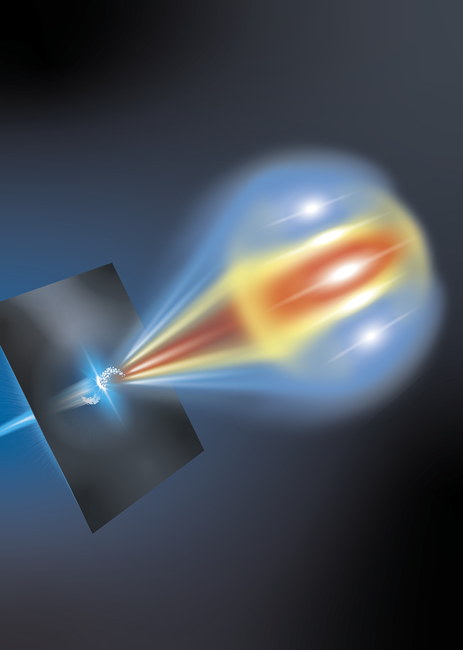According to a study published in Nature Photonics, researchers at the Helmholtz-Zentrum Dresden-Rossendorf (HZDR) have devised a unique measurement method that will aid in advancing laser-plasma acceleration.
 A structured beam of electron beamlets (modulated group of white spheres) passes through a metallic foil from left to right, creating coherent optical transition radiation (COTR). This radiation encodes unique beam structure information at each wavelength, as depicted by the different red, yellow and blue radiation patterns. Image Credit: HZDR / Blaurock
A structured beam of electron beamlets (modulated group of white spheres) passes through a metallic foil from left to right, creating coherent optical transition radiation (COTR). This radiation encodes unique beam structure information at each wavelength, as depicted by the different red, yellow and blue radiation patterns. Image Credit: HZDR / Blaurock
Laser-plasma accelerators are regarded as extremely promising research instruments since they require less space than traditional facilities, which can be kilometers long. Such tiny particle sources could efficiently accelerate electron bunches, allowing X-ray lasers to fit in the basement of a university laboratory.
However, there are a few obstacles to overcome: to create UV or x-ray light, the electron bunches generated by a laser-plasma accelerator must be very finely packaged and have certain qualities. To date, it has been impossible to accurately quantify these bunches.
In laser-plasma acceleration, a laser emits powerful light pulses into a gas. The pulse is so intense that it ionizes the gas, producing a plasma of electrons and ions. As the laser pulse moves the lighter electrons faster than the heavier ions, an electrically positively charged "bubble" forms behind them.
If electrons are put into this bubble, the intensity of the electro-magnetic field can propel them ahead. This procedure just takes a few centimeters but can accelerate electrons in bunches as much as a traditional setup that measures dozens or even hundreds of meters and employs radio waves to move the particles.
The free electron laser (FEL) is a promising application for cutting-edge laser-plasma accelerators. Electron bunches travel at almost the speed of light through a device known as an undulator.
This arrangement of magnets pushes the particles to follow slalom routes, causing them to shoot powerful, laser-like X-ray or UV flashes that may be used to detect incredibly rapid processes such as chemical reactions that occur in quadrillionths of a second.
Compact and Cost-Effective
This research equipment has several kinds, including the European XFEL near Hamburg. They are based on standard linear accelerators, which can be several kilometers long.
However, because these facilities are scarce, available beamtime is restricted. If FELs could be developed using laser-plasma accelerators, the facilities would be so small and cost-effective that a university institute, for example, could afford them. As a result, many more research teams would have access to the technology than they have now.
Initial successes have already been achieved: since 2021, three research groups - a team in Shanghai, China, a group in Frascati, near Rome, and a team working with physicist Dr. Arie Irman at HZDR's Institute for Radiation Physics - have demonstrated that a FEL based on plasma accelerators is feasible.
In a review article published in the journal Nature Photonics, the researchers outline the present stage of progress and list the unresolved research topics.
Among other things, we have to improve the quality and stability of the accelerated electron bunches and minimize the distribution of the electrons’ energy within the bunches. But it is also important to develop new diagnostic methods in order to investigate the processes in a laser-plasma accelerator more precisely.
Dr. Arie Irman, Research Group Leader Laser-Electron Acceleration, Helmholtz-Zentrum Dresden-Rossendorf
Electron Bunches Traverse Foil
Here is where the new HZDR project comes in. Dr. Maxwell LaBerge, a postdoc in Irman’s team, has created a measurement approach that allows scientists to examine in detail extremely brief electron bunches measuring only a few micrometers.
We shoot the electron bunches, almost at the speed of light, from the plasma accelerator onto a thin metal foil. This sets the electrons on the surface of the foil in motion.
Dr. Maxwell LaBerge, Postdoctoral Researcher, Helmholtz-Zentrum Dresden-Rossendorf
As a result, these electrons emit a signal that sensors can detect, similar to a transmitting antenna.
While describing the process, which is technically known as Coherent Optical Transition Radiation (COTR), LaBerge added, “Using this signal, we can precisely reconstruct what the electron bunches that have traversed the foil look like.”
HZDR specialists utilized their novel measurement method to investigate various methods of introducing electrons into the plasma bubbles.
Irman stated, “We have been able to ascertain that different injection methods produce quite different forms of electron bunches, which shows that the new method can help to control the form and structure of the electron bunches much more precisely.”
Additionally, the light produced in a FEL is brighter and more steady the better control there is over the rapidly accelerating electron bunches.
Journal References:
LaBerge, M., et. al. (2024) Revealing the three-dimensional structure of microbunched plasma-wakefield-accelerated electron beams. Nature Photonics. doi.org/10.1038/s41566-024-01475-2
Galletti, M., et. al. (2024) Prospects for free-electron lasers powered by plasma-wakefield-accelerated beams. Nature Photonics. doi.org/10.1038/s41566-024-01474-3